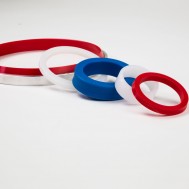Hydraulic seals play an important role in transferring fluid throughout a hydraulic system and preventing detrimental leaks. While these seals work to improve efficiency and extend the system’s lifespan, faulty seal design can lead to seal failure—causing costly downtime and further equipment complications.
In order to prevent hydraulic seal failure, it’s important to know the most common reasons why failures occur and practical methods to avoid them. Here’s a closer look at what you need to look out for.
1. Hardening
Hydraulic seals can harden when exposed to high-speed heat generation or high fluid temperature in applications. Hardening results in cracks and loss of elasticity in seals, which ultimately leads to seal failure.
To prevent hardening, reduce the stroke speed or temperature in the system if possible. You should also make sure that your seal is the right material to withstand hydraulic environments. To learn more about the different properties of rubber materials, visit our Material Selection Guide.
2. Wear
Wear can usually be detected by one side of the dynamic lip or face seal displaying excessive damage. In some instances, the face of a seal can be worn into a glossy mirror-like shine. This is commonly caused by a lack of lubrication or excessive lateral load.
To prevent wear, conduct regular preventative maintenance by inspecting and replacing worn bearings, rods and other components that can contribute to the wear of your seal. Also be sure to regularly maintain lubrication for optimal performance.
3. Fracturing
Fracturing occurs when a seal is burned, material is broken off or long cracks or splits appear on the V portion of the seal. This is often caused by excessive back pressure, spikes in pressure, an explosion of residual air at high pressure or low-grade sealing materials.
To prevent fracturing, ensure pressure release valves are functioning properly and maximum pressure settings are within normal limits. You should also ensure that the right high-quality material is chosen during the seal manufacturing process that can handle high-pressure environments.
4. Scarring
Scarring can be identified as small scratches, cuts or dents to the seal surface. This is often caused by improper installation or foreign material present in the liquid passing through the seal.
To prevent scarring, start by flushing the system of any contamination. Before installation, seals should be properly stored and transported carefully to avoid any premature damage. Be sure to inspect seals after installation to ensure they are free of any damage and can function properly.
Want to learn more about hydraulic seals?
Tweet us @AppleRubber to continue the conversation.
